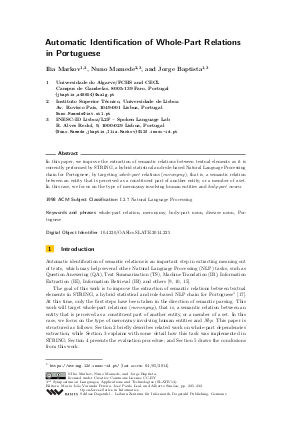Automatic Identification of Whole-Part Relations in Portuguese
Authors Ilia Markov, Nuno Mamede, Jorge Baptista
-
Part of:
Volume:
3rd Symposium on Languages, Applications and Technologies (SLATE 2014)
Part of: Series: Open Access Series in Informatics (OASIcs)
Part of: Conference: Symposium on Languages, Applications and Technologies (SLATE) - License:
 Creative Commons Attribution 3.0 Unported license
Creative Commons Attribution 3.0 Unported license
- Publication Date: 2014-06-18
File

PDF
OASIcs.SLATE.2014.225.pdf
- Filesize: 0.96 MB
- 8 pages
Document Identifiers
Subject Classification
Keywords
- whole-part relation
- meronymy
- body-part noun
- disease noun
- Portuguese
Metrics
- Access Statistics
-
Total Accesses (updated on a weekly basis)
0Document
0Metadata
Abstract
In this paper, we improve the extraction of semantic relations between textual elements as it is currently performed by STRING, a hybrid statistical and rule-based Natural Language Processing chain for Portuguese, by targeting whole-part relations (meronymy), that is, a semantic relation between an entity that is perceived as a constituent part of another entity, or a member of a set. In this case, we focus on the type of meronymy involving human entities and body-part nouns.
Cite As Get BibTex
Ilia Markov, Nuno Mamede, and Jorge Baptista. Automatic Identification of Whole-Part Relations in Portuguese. In 3rd Symposium on Languages, Applications and Technologies. Open Access Series in Informatics (OASIcs), Volume 38, pp. 225-232, Schloss Dagstuhl – Leibniz-Zentrum für Informatik (2014)
https://doi.org/10.4230/OASIcs.SLATE.2014.225
BibTex
@InProceedings{markov_et_al:OASIcs.SLATE.2014.225,
author = {Markov, Ilia and Mamede, Nuno and Baptista, Jorge},
title = {{Automatic Identification of Whole-Part Relations in Portuguese}},
booktitle = {3rd Symposium on Languages, Applications and Technologies},
pages = {225--232},
series = {Open Access Series in Informatics (OASIcs)},
ISBN = {978-3-939897-68-2},
ISSN = {2190-6807},
year = {2014},
volume = {38},
editor = {Pereira, Maria Jo\~{a}o Varanda and Leal, Jos\'{e} Paulo and Sim\~{o}es, Alberto},
publisher = {Schloss Dagstuhl -- Leibniz-Zentrum f{\"u}r Informatik},
address = {Dagstuhl, Germany},
URL = {https://drops.dagstuhl.de/entities/document/10.4230/OASIcs.SLATE.2014.225},
URN = {urn:nbn:de:0030-drops-45723},
doi = {10.4230/OASIcs.SLATE.2014.225},
annote = {Keywords: whole-part relation, meronymy, body-part noun, disease noun, Portuguese}
}
